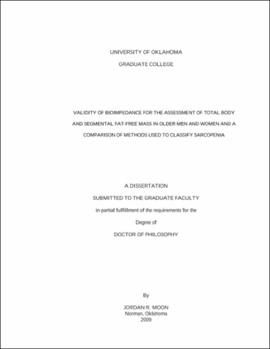| dc.contributor.advisor | Stout, Jeffrey R | |
| dc.creator | Moon, Jordan Robert | |
| dc.date.accessioned | 2019-04-27T21:22:16Z | |
| dc.date.available | 2019-04-27T21:22:16Z | |
| dc.date.issued | 2009 | |
| dc.identifier | 9913361102042 | |
| dc.identifier.uri | https://hdl.handle.net/11244/318520 | |
| dc.description.abstract | The purpose of the current investigation was to evaluate the validity of several total body fat-free mass (FFM), muscle mass (TBMM), water (TBW), and appendicular lean mass (ALM) equations in older adults compared to a criterion four-compartment (4C) model and dual-energy X-ray absorptiometry (DXA). Additionally, this investigation examined two body composition-based methods for the classification of sarcopenia. Seventy-four healthy older men (n = 32) and women (n = 42) participated in the investigation (mean ± SD, age = 72 ± 6 years, height =167.5 ± 8.5 cm, mass = 69.49 ± 12.71 kg). Body composition was assessed using bioimpedance analysis (BIA/MFBIA) and spectroscopy (BIS) and compared to a 4C model and DXA. Additionally, relative skeletal muscle index (RSMI) and skeletal muscle index (SMI) were calculated using DXA and BIA, respectively. In both men and women, TBW methods produced low SEE values (< 1.57 kg) and high r values (> 0.92), but meandifferences were observed (> -2.01 L) compared to deuterium oxide. A BIS-estimated TBW two-compartment model produced low SEE values (< 2.17 kg) and high r values (> 0.88), but mean differences were observed (> -3.71 kg) compared to the 4C model. BIS TBMM equations resulted in low SEE values (< 2.28 kg) and high r values (> 0.79), but mean differences were observed (> -0.68 kg) in all but one equation for men and women combined, and one for the women alone compared to DXA muscle mass values. Equations for ALM estimated via BIS resulted in low SEE values (< 2.07 kg) and high r values (> 0.69), but mean differences were observed (> -1.20 kg) compared to DXA lean mass values. A MFBIA device produced low SEE values (< 2.14 kg) and high r values (> 0.77), but mean | |
| dc.description.abstract | differences were observed (> -0.42 kg with the exception of lean mass in the legs for men, compared to the 4C model and DXA. All BIA FFM equations produced low SEE values (< 2.29 kg) and high r values (> 0.83), but mean differences were observed (> 1.11 kg) with the exception of one equation for all groups and one equation for women only, compared to the 4C model. Total body muscle mass estimated via BIA resulted in low SEE values (< 2.14 kg) and high r values (> 0.81), but mean differences were observed (> -0.50 kg). Appendicular lean mass BIA and MFBIA produced low SEE values (< 1.68 kg) and high r values (> 0.83), but mean differences were observed (> -0.71 kg) with the exception of one equation for all groups and the MFBIA in men. Of the ALM equations, one produced valid results (r > 0.75, SEE < 0.48) for RSMI compared to DXA. This equation resulted in a total accuracy of 91% in all men and women compared to DXA RSMI for the classification of sarcopenia. Comparing a TBMM equation that has been used to classify sarcopenia to DXA muscle mass, there was a 69% agreement. The BIA-based sarcopenia classification method indicated forty-four subjects as sarcopenic, while the DXA-based method only classified sixteen as sarcopenic. Total agreement between sarcopenia classification methods was only 24%. Mean differences suggest corrections are needed for systematic deviations produced by nearly all equations. However, there are accurate BIA equations, and more complicated MFBIA and BIS equations were no better than these BIA equations. Therefore, BIA is an acceptable method to predict both FFM and ALM in older men and women and can be used as an alternative to DXA or a 4C model. Poor agreement between sarcopenia classification methods indicates a need for a standardized procedure. Nonetheless, the accurate ALM BIA equation used to predict RSMI for use in sarcopenia classification produced an individual accuracy of 91%, suggesting that using an ALM equation to predict DXA ALM is more appropriate than generating a new BIA-based sarcopenia classification method. | |
| dc.format.extent | 113 pages | |
| dc.format.medium | application.pdf | |
| dc.language | en_US | |
| dc.relation.requires | Adobe Acrobat Reader | |
| dc.subject | Electrophysiology | |
| dc.subject | Impedance, Bioelectric | |
| dc.subject | Muscles--Aging | |
| dc.subject | Muscles--Diseases--Age factors | |
| dc.subject | Geriatrics | |
| dc.title | Validity of bioimpedance for the assessment of total body and segmental fat-free mass in older men and women and a comparison of methods used to classify sarcopenia | |
| dc.type | text | |
| dc.type | document | |
| dc.thesis.degree | Ph.D. | |
| ou.group | College of Arts and Sciences::Department of Health and Exercise Science | |
